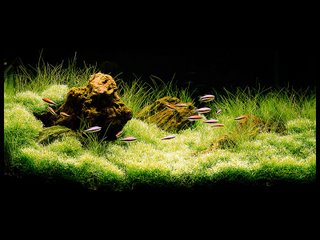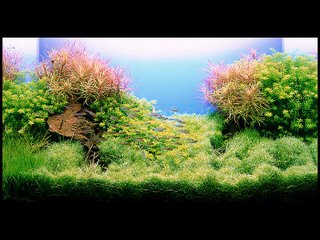 This is the first in a series of posts about the fundamentals of aquascaping. I'm posting these because I've found them very helpful in creating an aesthetically pleasing aquascape. They are by no means the "rules" of aquascaping, just guides.
This is the first in a series of posts about the fundamentals of aquascaping. I'm posting these because I've found them very helpful in creating an aesthetically pleasing aquascape. They are by no means the "rules" of aquascaping, just guides. When you're planning out an aquascape, one of the most important aspects is where it will draw the viewer's gaze. In fact, a viewer's gaze is what the aquascape is all about. The primary goal of an aquascape is to be pleasing, relaxing, and interesting to look at for the viewer. In order to do so, you need to set a sort of "anchor" for the mind. This is called the focal point. It is the point that draws the gaze of the viewer first, from which they can explore the rest of the tank. A focal point can consist of almost anything, from a red leaved plant to a rock or a piece of driftwood. The only thing it must do is draw attention. You can't have a plant that blends in with every other plant be the focal point, you have to make it stand out in some way. There are a few simple things to remember about a focal point.
First, there should only be one. Having more than one focal point leaves the mind uncomfortable and stressed, looking back and forth from focal point to focal point. Only in extremely large tanks may you have two focal points comfortably. Second, you should have some sort of focal point in every aquascape. Not having any does the same as having too many: the viewer's eyes are left wandering back and forth, stressed and uncomfortable. Third, the focal point should be placed in a very particular (and special!) location. This is where we come to the Golden Rule of aquscaping. This Golden Rule dates all the way back to the Greeks. It seems the they came up with a theory that the ratio 1:1.618 was the most pleasing to the human eye. Many people assume that plopping the focal point in the middle is most pleasing, however, this will again keep your eyes wandering left and right. By placing it slightly off center, you are effectively gently guiding the viewer's eyes. You'll see this Golden Rule used in all forms of art, from paintings to architecture. But how do you use this Golden Rule in the aquarium?
It's actually fairly easy. All you need is a measuring tape (or ruler) and a calculator. Simply measure your tank lengthwise from one end to the other. Then divide that number by 2.618. A 29 gallon tank, as an example, is 30 inches wide. 30 divided by 2.618 is 11.45 inches. Now take your measuring tape again and measure 11.45 inches from one side of the tank (you can measure from either side, but which side to put the focal point on is up to you). At exactly 11.45 inches exists an imaginary line. This is where your focal point should be centered.

The picture above shows an example of how Takashi Amano has used the Golden Rule in his aquascape. As you can see, he has placed a red, tall pant right at the Golden Rule, creating an effective, pleasing focal point. Take a look at the following aquascapes by Amano and see if you can find the focal point and the use of the Golden Rule:






LOVE your blog! I have recently become interested in aquascaping and am just getting ready to jump in. Looking forward to reading all your entries.
ReplyDeleteyour blog it's great ,i've seen lots of places but yours for me is the # 1 keep the great job greetings from mexico city juan chong
ReplyDeleteThis site is awesome and more informative than any other site I've been to.
ReplyDeletedude..you're awesome..keep update..
ReplyDeleteSame thing to say as everyone else, I've been to loads of sites but this one is the best! Thanks!
ReplyDeleteindeed, well played sir
ReplyDeleteI had a question more than a comment, with so much emphasis on plant root structure and nourishent, why is there no tool or system available for delivering fertilizer directly to the roots? I know there are root tabs available, but I thought about using regular air tubing during the initial set up of the tank to use along with the undergravel heating cable underneath the substrate. The idea would be to inject liquid fertilizer once a week directly to the roots with an oversized shringe. This way liquid fertilzer could be injected directly underneath the substrate. You could even aerate the solution first in which you would now be injecting O2 and liquid fertilizer into the substrate for the roots. I am certainly no aquarium expert, but would this not work? You could even inject O2 by itslef if fertilization is not required or in places where there are no fauna planted. i have read one of the challenges with using silver sand, despite how good it looks, is that because it is so fine of a substrate, the medium becomes stagnent due to poor circulation of O2 within the substrate that the silver sand quickly becomes black and scummy. Again, I am certainly no aquirium expert, but would aerating the substrate for 2min once a week not help with this issue.
ReplyDeleteany thoughts?
scerby1@hotmail.com
love your site!
ReplyDeleteThis site has a lot of useful info. Keep it up.
ReplyDeleteI saw a Marine aquascape on http://www.cheapfishtanks.com.au/ but it doesn't seem to use the Golden rule and it still looks great, any thoughts?
ReplyDeleteHello, wonderful post. I've looked back at it many times as I've set up my aquarium. Any chance there could be a part of your blog where people can post pictures of their aquarium/aquascape & receive constructive feedback (on placement, use of the Golden Rule, etc.)? Thanks!
ReplyDelete